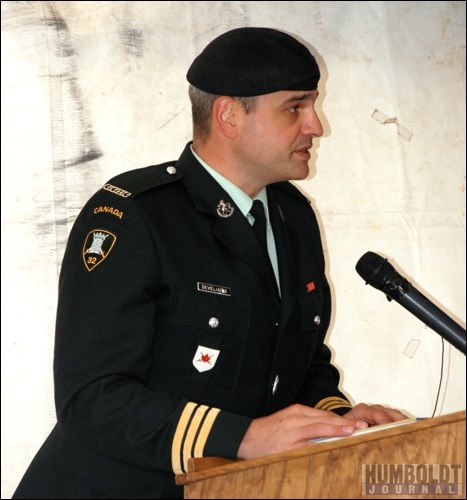Last year, there was one. This year, there will be 15.
Fifteen members of the Governor General's Horse Guard will be paying a visit to Humboldt in late June; not only to the present city, but to the site of the original settlement.
The Governor General's Horse Guards was once called the Goveral General's Body Guard, and under thecommand of one Lt.-Col. George T. Denison, the Body Guard set up camp at Humboldt, near the Telegraph Station, in 1885.
Fort Denison, as the site of the encampment is now referred to, was where the soldiers guarded supplies for the troops under the command of General Frederick Middleton, who was fighting Louis Riel's forces at Batoche in the 1885 North West Rebellion.
They left Humboldt in the summer of 1885, once the rebellion had been quelled, but left behind archeological evidence that they had been there, some of which has been uncovered by recent digs at the site.
And this summer, the soldiers are coming back.
It was last year that the invitation was extended, explained Jennifer Hoesgen, director of the Humboldt and District Museum and Gallery (HDMG), the body that has been responsible for the research and development of the Original Humboldt site since it was purchased to be held in public trust a few years ago.
Last summer, an official commemoration ceremony of the Original Humboldt site was held on the land, located about eight kilometres southwest of the present city.
Attending that ceremony was Lt.-Col. Glenn Develiadis, the present commanding officer of the Governor General's Horse Guards.
While in Humboldt, he shared some of the historical information he had gathered on the troops' activities while in Humboldt, and noted that the North West Rebellion is an important event in the history of his unit. It's actually the first battle honour that is emblazoned on their standard.
Develiadis also presented the Original Humboldt committee with a print of a painting that hangs in their mess, depicting Denison and the Body Guard on the way to Saskatchewan. He also gave the HDMG a copy of their regimental history.
It was at that event, Hoesgen explained, that it was said that it would be nice if the soldiers of the regiment could come back.
Early in 2012, that invitation was accepted.
The fifteen soldiers will arrive in Humboldt June 22, and will actually appear in the Humboldt parade on June 23.
"They will be (our) special guests, marching in the parade," Hoesgen said.
Their parade appearance will precede a flag ceremony to take place at the Original Humboldt site at 1:30 p.m.
"We hope to do it right on the Fort Denison area of Original Humboldt," Hoesgen said. "Weather permitting."
The archeological dig of the Ford Denison area will be continuing this summer, it was noted, but that work does not start until July.
"It's going to be a very brief ceremony," Hoesgen said of the day's events, as the site was already officially launched last year. "It's simply to commemorate the soldiers' first visit back to the area since 1885."
Though short, the ceremony will be important, as it recognizes the soldiers' place in the history not only of this region, but of this country.
"I think the military aspect of the Original Humboldt site is really important to Canadian history," said Hoesgen. "It's a bigger story than just Humboldt. For these troops to acknowledge this really important aspect of their regimental history, and for them to make the trip from Ontario to stand on the land where their predecessors stood, demonstrates how important this site is to Canadian history."
It's also very important to hold a ceremony, she added, to acknowledge the history of the land and to raise awareness of its historical importance.
After the ceremony at Fort Denison, the soldiers will be attending a supper at the Humboldt Legion - a fundraiser for the organization - where they will be doing a public presentation on the history of the Governor General's Horse Guards in 1885.
Also in conjunction with the ceremonies of the weekend, the Saskatchewan Archaeological Society will be hosting their ArchaeoCaravan out at the Original Humboldt site. It will be open to the public on June 23, and will allow people of all ages to try their hand at "bison hunting" and rock painting.
Hoesgen is hoping that through the hosting ofthis regiment of soldiers, they will be able to pool their information about what happened at Ford Denison.
"We want to know more about the history of the regiment," Hoesgen said, so they can perhaps better understand some of the archeological findings they are discovering at Ford Denison.




